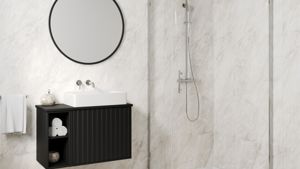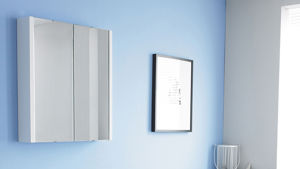If the kitchen is considered the heart of the home, then the kitchen sink can definitely be seen of as the left ventricle; without it, you wouldn’t have a functioning heart.
A good quality sink should last you at least 15 years - potentially even a lifetime - and thanks to advances in technology, a good quality, stylish kitchen sink doesn’t have to cost a fortune. But with nearly 700 sinks on sale here at Tap Warehouse, and so many styles, sizes, materials and colours to choose from, how do you know which is the right one for you kitchen? In this guide we’ll take a look through the things that you need to look out for when buying a new kitchen sink.
Sink Size Vs. Kitchen Size?
Perhaps the most important thing to consider before buying a new kitchen sink is the amount of space that you have available. You may have your eye on that gorgeous double bowl ceramic Belfast sink, but if you’ve only got space for a sink that’s 700mm wide, it’s going to be an awkward phone call from your installer to tell you that you’ve bought a sink that’s too large.

Larger Kitchens
If you have a large kitchen and a large worktop area, then you may have free reign over the size and style of your new sink. We would recommend getting a 1.5 or 2 bowl sink to give you maximum practicality. With a double bowl sink, you can let dishes soak in hot water in one of the bowls and still have a second bowl free for preparing food, making drinks, or anything else that requires your sink. One thing to take into consideration is whether you’d like a sink with a drainer or whether you prefer the look of one without. We’ll talk more about this later in our Undermount Sinks section.
Here are a few of our favourite large kitchen sinks which are ideal for bigger kitchens:
Smaller Kitchens
If you have a smaller kitchen, your options are slightly more limited, but there is still a fantastic selection to choose from. Again, you may wish to forgo a drainer and have a sink with a slightly larger bowl. Bowl size isn’t everything though; it’s no point having a huge bowl if you’ve then got nowhere to let your dishes dry.
Here are a few of our favourite sinks for smaller kitchens:
Material
Once you’ve decided whether you need a small or large kitchen sink, the next thing is deciding which material you’d like. It’s a big decision, and each material has its pros and cons. Fortunately then, we’ve written a whole separate advice guide to help you choose the right material for your kitchen sink.
Top Mounted
The classic ‘top mounted’ sink is something that we’re all familiar with. It’s comfortably the most common way of fitting a sink, as well as the most straightforward. A top mount - or inset - sink sits on your worktop and if you’re buying a sink to replace one of a similar size, you often won’t have to do any work to your worktop; your new sink will simply slot into the same gap as your old one. This is one of the benefits of a top mounted sink. Another one is that it’s possible for a top mounted sink to fit on almost any worktop, no matter what it’s made from.
As we’ll see shortly, when you undermount a sink, you must make sure that your worktop is strong enough to support your sink. One of the cons of top mounted sinks is that where they join the worktop, there is a lip which acts as a magnet for crumbs and other debris. Also, if the sink isn’t sealed properly to the worktop, water can get in and cause mould and ruin your worktop.
Here are a few of our greatest hits when it comes to top mounted sinks.
Undermount
Undermounting a sink is the current ‘on trend’ way of mounting a kitchen sink. Undermount sinks are a great way of saving space in your kitchen as well, as most don’t have a drainer, so you only need space for the bowl(s). This makes them ideal for smaller kitchens and for those that prefer a more minimalist design in their kitchen.
One of the great things about undermount sinks is how easy they are to clean. As we mentioned when talking about top mounted sinks, the join between sink and worktop is a honey trap for debris and water. With an undermount sink, however, there is no lip. Crumbs can simply be wiped straight from the worktop into the sink, making cleaning (and keeping it clean) around your worktop so much easier.
As with everything, undermount sinks do have their drawbacks, but it’s up to you to decide whether they’re enough to stop you getting one. As we’ve touched on, you will need a solid granite or stone worktop if you’re looking to install an undermount granite or ceramic kitchen sink; a laminate worktop will simply not be strong enough to support the weight. You should be alright to install a stainless steel undermount sink on any worktop, but we strongly advise checking with your installer first to avoid making a costly (and messy) mistake.
Most undermount sinks don’t come with a drainer, so you’ll either have to purchase a separate draining board, or forgo one altogether. Finally, undermount sinks are notoriously tricky to install. We always recommend using a qualified plumber for any installation, but this is doubly important when it comes to undermount sinks.
Here are some of our top picks.
Sit-on
Sometimes called an apron-front sink, a sit-on kitchen sink does exactly what it says on the tin - it sits on your kitchen cabinet. Sit-on sinks are very stylish, and with the exposed front, creates a country-style feel in your kitchen. Most sit-on sinks are made from ceramic and are extremely heavy, therefore your worktop must be strong enough to support it. Ceramic Belfast sinks can weigh anything up to 75kg, and when you take into account that at some point it’s going to be filled with water and dishes, it means that your worktop will have to be able to hold in excess of 100kg. Like undermount sinks, sit-on sinks must only be installed by a qualified installer. We’ve heard too many stories of DIY attempts gone wrong not to warn you! Also, like undermount sinks, they are easy to keep clean as crumbs can be brushed into the sink straight from the worktop.
Let's take a look at a selection of our Belfast & Butler Kitchen Sinks.








